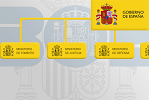Establishing the assets and liabilities of the bankrupt’s estate and the end of the bankruptcy
Content
Establishment of the assets of the estate
The assets of the bankrupt estate consist of:
- goods and rights which belonged to the debtor's assets on the date of declaration of bankruptcy;
- and goods and rights added to, or acquired by, the estate up to conclusion of the procedure, unless they cannot, by law, be attached even though they count as assets.
To establish the assets, it is necessary to know what is available to satisfy the creditors’ claims.
The bankruptcy administration must draw up the inventory of goods and rights at the date of cessation of trading, which will be the day before the date of the report. The inventory must list and value the debtor’s goods and rights belonging to the assets of its estate.
The following must accompany the inventory:
- A listing of all litigation, the outcome of which may affect the inventory content;
- A full list of legal actions which, in the opinion of the bankruptcy administration, have to be instituted to reinstate the assets of the estate.
Establishment of the liabilities of the estate
The liabilities of the bankrupt estate consist of
- all ordinary or other creditors of the debtor which has been declared bankrupt, irrespective of their nationality and domicile, without prejudice to the exceptions allowed by law.
When establishing the liabilities of the estate, in principle a distinction must be drawn between:
- debt claims against the bankrupt estate, which are excluded from the liabilities; and
- creditors in bankruptcy who, in turn, the law classifies as:
- preferential creditors: creditors with special privilege and creditors with general privilege;
- ordinary creditors; and
- subordinate creditors.
Debt claims against the bankrupt estate:
- These are claims caused by, rather than causing, the bankruptcy.
- By definition they arise after the institution or general declaration of bankruptcy
- and are pre-deductible. Before proceeding to pay the creditors in bankruptcy, the bankruptcy administration must deduct from the assets of the estate the necessary goods and rights, not earmarked for satisfaction of creditors with special privilege, to satisfy the debt claims against the estate.
Creditors in bankruptcy:
- These are creditors participating in the bankruptcy subject to two requirements: their claims must be against the common debtor, and must not be classifiable as debt claims against the estate.
Creditors with special privilege:
- these are creditors with preferential status in relation to certain goods or rights.
- They may abstain from voting on the debt restructuring plan.
Creditors with general privilege:
- these are creditors under Article 91 of the Bankruptcy Law (22/2003)
 .
. - They may abstain from voting on the debt restructuring plan
- and will be paid when the goods and rights necessary to satisfy debt claims against the estate have been deducted from its assets. They are paid from assets not subject to special privilege, or from the residue once debt claims against the estate have been paid. Payment will be made in the order established by Article 91 of the Bankruptcy Law (22/2003) and, where applicable, pro rata at each level of the ranking.
Ordinary creditors:
- These are creditors which are neither preferential nor subordinate.
- Their claims will be paid from the residue of the goods and rights belonging to the assets of the estate which remain after meeting debt claims against the estate and satisfying preferential creditors.
Subordinate creditors:
- these are listed in Article 92 of the Bankruptcy Law
 (22/2003).
(22/2003). - Subordinate creditors are only paid when ordinary creditors have been fully satisfied. Subordinate creditors are paid in the order established under Article 92.
What happens after the joint supervision stage?
The bankruptcy administration submits the final versions of the inventory and ranking of creditors. The court then issues an order closing the joint supervision stage and agreeing to commence the debt restructuring or winding-up stage, as applicable.
1. Debt-restructuring plan
The Bankruptcy Law establishes the contents which the proposed debt restructuring plan must have, and the formula of consent to it. In any case the plan must contain:
- proposals for a temporary arrangement with the creditors,
- for conversion of debt into shares or participating interests,
- of all consenting creditors.
The law also allows alternative contents for the proposal for an arrangement with creditors: for all creditors, or creditors of one or more classes, except public creditors.
Alternative proposals may include:
- offers for conversion of the debt into shares, participating interests or units, convertible bonds, ancillary credits, shareholders’ credits, loans with interest which can be capitalised, or any other financial instrument of different rank, maturity or features from the original debt.
The proposed arrangement with creditors must be backed by a payment plan and, where appropriate, a feasibility study.
2. Winding up
Winding up is an option open to the debtor from the time of the petition for voluntary bankruptcy, or from the order declaring the debtor involuntarily bankrupt, or during the shared supervision stage (unless a proposal has been submitted in advance).
There are also conditions for opening a liquidation office in the following cases:
- either no proposal for an arrangement with creditors has been submitted;
- or no proposal is admitted;
- or the meeting of creditors does not accept the proposal;
- or the arrangement is rejected by final court order;
- or a court rules the arrangement invalid, or it is not implemented.
Once the winding-up stage begins, the bankruptcy administration must draw up a winding-up plan. to realise the goods and rights belonging to the assets of the estate.
The commencement of winding up entails suspension of the bankrupt's powers to administer and dispose of its assets, which will be exercised by the bankruptcy administration, unless otherwise agreed in advance.
If the bankrupt is a legal person, the order opening the winding-up stage will agree to dissolution, if not already agreed. The directors or liquidators will cease to serve, and be replaced by the receivers in bankruptcy.
As for the effects on the creditors, the opening of winding up entails conversion to cash of credits which exist in kind, and early maturity of deferred bankruptcy credits.
How does the arrangement finish?
The law governs the grounds of conclusion of the bankruptcy. There are various grounds for concluding the bankruptcy:
- some grounds relate to arrangements which were commenced in breach of the law (revocation of the order declaring bankruptcy);
- others to the purpose of the bankruptcy (completion of the arrangement or entire satisfaction of creditors), or because the bankruptcy was frustrated (no goods and rights existed, or the estate was insufficient to settle the claims against it);
- or exercise of the parties’ right of disposal, at the end of the shared supervision stage, when the decision accepting the withdrawal or relinquishment of all recognised creditors has become final.
The Bankruptcy Law allows appeals against conclusion of the bankruptcy, within the time limit allowed to the parties for a hearing, which will take place in accordance with the formalities for the bankruptcy proceedings.
Provision also exists to reopen a bankruptcy after issue of the order for its conclusion.
Legal and/or technical references
-
Royal Legislative Decree 1/2010 of 2 July 2010 approving the revised text of the Law on stock corporations

-
Law 3/2009 of 3 April 2009 on structural modifications of commercial companies

-
Royal Legislative Decree 1/2020 of 5 May 2020 approving the consolidated text of the Bankruptcy Law

-
Tax obligations – central Tax Agency

-
Employment obligations – Social Security

-
Online registrars

-
Madrid commercial registry – registers

-
Public register of bankruptcies











